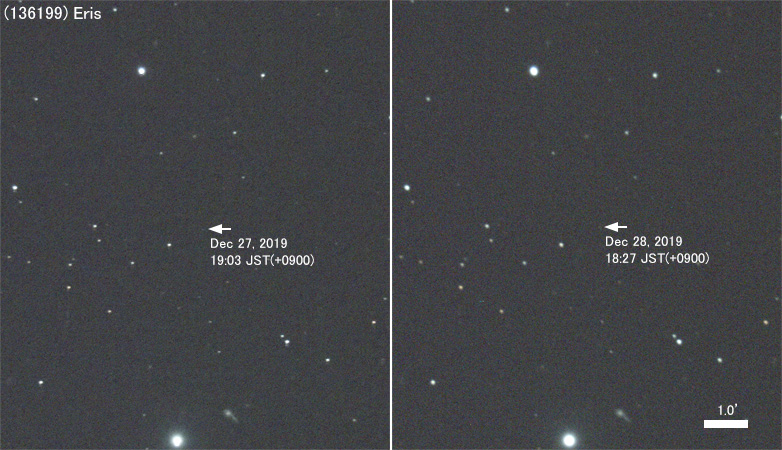| Date & Time: | Dec 27 2019, from 18:59 to 19:06 JST(+0900), 3min.×2shots |
| Dec 28 2019, from 18:22 to 18:33 JST(+0900), 3min.×4shots |
| Optical: | Meade 25cm(10") Schmidt-Cassegrain with conversion lens (f=1600mm, F6.3) |
| with BaaderPlanetarium Moon&Skyglow filter |
| Auto-guided with Meade LX200 Equatorial & Pictor 201XT |
| Digital Camera: | Nikon D810A |
| Location: | Ooizumi, Hokuto city, Yamanashi pref. |
| (136199) Eris |
|---|
| Semi-major axis | 67.781 au (10.140Bln km) |
|---|
| Perihelion distance | 37.911 au (5.671Bln km) |
|---|
| Aphelion distance | 97.651 au (14.608Bln km) |
|---|
| Orbital eccentricity | 0.441 |
|---|
| Orbital period | 558.04 yrs. |
|---|
| Parameters when photographed: |
| R.A. (2000.0) | 01h 42m 21.5s
→01h 42m 20.7s |
|---|
| Dec. (2000.0) | -02°01' 49"
→-02°01' 43" |
|---|
| Geocentric distance | 95.73 au (14.320Bln km) |
|---|
| Heliocentric distance | 96.02 au (14.364Bln km) |
|---|
| Magnitude | 18.6 |
|---|
Dwarf planet "Eris" is one of Trans-Neptunian Objects (TNOs) classified in the Plutoid, discovered on Oct 21, 2003.
Eris is revolving an elongated elliptical orbit with a period of 558 years far outside of the Pluto (247 years in period); the orbit tilts 43.8 degrees from the plane of the ecliptic.
A diameter of Eris has been estimated as approximately 2300 km, almost the same with that of the Pluto.
The dwarf planet was named after Goddess of war and dicord in the Greek mythology, registered as the second Plutoid next to the Pluto in August 2006.
This image has displayed by turning the celestial north direction upward.
When I photographed, Eris had a visual brightness of pretty dark 18.6th magnitude and was moving toward WNW slowly in the central region of Cetus.
Comparing two shots taken 24-hours apart, you can detect a Eris's apparent movement of approximately only 15 arc seconds.
Presently, Eris is located near the aphelion, so it's comparatively difficult to photograph it with amateur telescopes.
The dwarf planet will pass the perihelion and brighten up to 14th magnitude in the mid-23rd century 2258.
|

